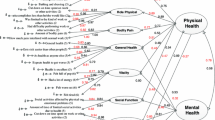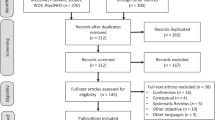Abstract
Objective
To identify response shift using two structural equation modeling (SEM) techniques.
Study design and setting
Hypertensive patients (n = 909) with coronary artery disease (CAD) completed SF-36 surveys at both baseline and 1-year follow-up. Response shift was identified using Oort and Schmitt SEM techniques. The type of response shift linked to changes in various parameters of the SEM measurement model is defined differently for both SEM approaches. Effect sizes were calculated for the impact of response shift on the change of SF-36 domain scores when using the Oort approach.
Results
Both Oort and Schmitt SEM approaches identified response shift only in the SF-36 physical functioning (PF) scale. The effect size of recalibration on the change of PF domain scores when using the Oort approach was −0.12.
Conclusion
This study showed that hypertensive patients with CAD experienced a response shift over a 1-year period. Both the SEM approaches identified response shift (uniform recalibration using the Oort approach and recalibration using the Schmitt approach); however, both approaches use different parameters to define and test response shift. We found that either the variation in analytic methods or the sample used may influence the identification and type of response shift.

Similar content being viewed by others
References
Goodwin, P. J., Black, J. T., Bordeleau, L. J., & Ganz, P. A. (2003). Health-related quality of life measurement in randomized clinical trials in breast cancer—taking stock. Journal of the National Cancer Institute, 95(4), 263–281.
Campbell, D. T. (1957). Factors relevant to the validity of experiments in social settings. Psychological Bulletin, 54(4), 297–312.
Sprangers, M. A., & Schwartz, C. E. (1999). Integrating response shift into health-related quality of life research: a theoretical model. Social Science and Medicine, 48, 1507–1515.
Schwartz, C. E., & Sprangers, M. A. (1999). Methodological approaches for assessing response shift in longitudinal health-related quality of life research. Social Science and Medicine, 48, 1531–1548.
Ried, L. D., Tueth, M. J., Taylor, M. D., Sauer, B. C., Lopez, L. M., & Pepine, C. J. (2006). Depressive symptoms in coronary artery disease patients after hypertensive treatment. Annals of Pharmacotherapy, 40, 597–604.
Chobanian, A. V., Bakris, G. L., Black, H. R., Cushman, W. C., Green, L. A., & Izzo, J. L., Jr. (2003). For the National Heart, Lung, and Blood Institute Joint National Committee on Prevention, Detection, Evaluation, and Treatment of High Blood Pressure; National High Blood Pressure Education Program Coordinating Committee. The seventh report of the Joint National Committee on Prevention, Detection, Evaluation, and Treatment of High Blood Pressure: the JNC 7 report. Journal of the American Medical Association, 289, 2560–2572.
Ahmed, S., Mayo, N., Corbiere, M., Wood-Dauphinee, S., Hanley, J., & Cohen, R. (2005). Change in quality of life of people with stroke over time: True change or response shift? Quality of Life Research, 14, 611–627.
Schmitt, N. (1982). The use of analysis of covariance structures to assess beta and gamma change. Multivariate Behavioral Research, 17, 343–358.
Schmitt, N., Pulakos, E. D., & Lieblein, A. (1984). Comparison of three techniques to assess group-level beta and gamma change. Applied Psychological Measurement, 8, 249–260.
Schaubroeck, J., & Green, S. G. (1989). Confirmatory factor analytic procedures for assessing change during organizational entry. Journal of Applied Psychology, 74(6), 892–900.
Oort, F. J. (2005). Using structural equation modeling to detect response shifts and true change. Quality of Life Research, 14, 587–598.
Ahmed, S., Bourbeau, J., Maltais, F., & Mansour, A. (2009). The Oort structural equation modeling approach detected a response shift after a COPD self-management program not detected by the Schmitt technique. Journal of Clinical Epidemiology, 62, 1165–1172.
Oort, F. J., Visser, M. R. M., & Sprangers, M. A. G. (2005). An application of structural equation modeling to detect response shifts and true change in quality of life data from cancer patients undergoing invasive surgery. Quality of Life Research, 14, 599–609.
Vandenberg, R. J., & Lance, C. E. (2000). A review and synthesis of the measurement invariance literature: Suggestions, practices and recommendations for organizational research. Organizational Research Methods, 3, 4–70.
Visser, M., Oort, F., & Sprangers, M. (2005). Methods to detect response shift in quality of life data: A convergent validity study. Quality of Life Research, 14, 629–639.
Ried, L. D., Tueth, M. J., Handberg, E., Kupfer, S., Pepine, C. J., & the INVEST study group. (2005). A study of antihypertensive drugs and depressive symptoms (SADD-Sx) in patients treated with a calcium antagonist versus an atenolol hypertension treatment strategy in the international verapamil sr-trandolapril study (INVEST). Psychosomatic Medicine, 67, 398–406.
Pepine, C. J., Handberg-Thurmond, E., Marks, R. G., Conlon, M., Cooper-DeHoff, R., Volkers, P., et al. (1998). Rationale and design of the International Verapamil SR/Trandolapril Study (INVEST): An Internet-based randomized trial in coronary artery disease patients with hypertension. Journal of the American College of Cardiology, 32, 1228–1237.
Pepine, C. J., Handberg, E. M., Cooper-DeHoff, R. M., Marks, R. G., Kowey, P., Messerli, F. H., et al. (2003). A calcium antagonist vs a non-calcium antagonist hypertension treatment strategy for patients with coronary artery disease. The International Verapamil-Trandolapril Study (INVEST): A randomized controlled trial. Journal of the American Medical Association, 290, 2805–2816.
Anonymous. (1997). World Medical Association Declaration of Helsinki. Recommendations guiding physicians in biomedical research involving human subjects. Cardiovascular Research, 35, 2–3.
Saris-Baglama, R. N., Dewey, C. J., Chisholm, G. B., Kosinski, M., Bjorner, J. B., & Ware, J. E. (2004) SF-36 Health outcomes scoring software, pp 1–157.
Ware, J. E., Snow, K. K., Kosinski, M., & Gandek, B. (1993). SF-36 health survey: Manual and interpretation guide. Boston, MA: The Health Institute, New England Medical Center.
Jöreskog, K., & Sörbom, D. (1993). LISREL 8. Lincolnwood, Il: Scientific Software Internatonal Inc.
SAS Institute. SAS users guide, version 9.1. (2004) Cary, NC; SAS institute, Inc.
Brown, T. A. (2006). Confirmatory factor analysis for applied research. New York: London: Guilford Press.
Barclay-Goddard, R., Lix, L. M., Tate, R., Weinberg, L., & Mayo, N. E. (2009). Response shift was identified over multiple occasions with a structural equation modeling framework. Journal of Clinical Epidemiology, 62, 1181–1188.
Cohen, J. (1988). Statistical power analysis for the behavioral sciences (2nd ed.). Hillsdale, NJ: Lawrence Erlbaum Associates, Inc.
King-Kallimanis, B., Oort, F. J., Visser, M. R. M., & Sprangers, M. A. G. (2009). Structural equation modeling of health-related quality-of-life data illustrates the measurement and conceptual perspectives on response shift. Journal of Clinical Epidemiology, 62, 1157–1164.
Bar-On, D., Lazar, A., & Amir, M. (2000). Quantitative assessment of response shift in QOL research. Social Indicators Research, 49, 37–49.
de Graff, J. C., Ubbink, D. Th., Kools, E. J. C., Chamuleau, S. A. J., & Jacobs, M. J. H. M. (2002). The impact of peripheral and coronary artery disease on health-related quality of life. Annals of Vascular Surgery, 16, 495–500.
Mitchell, R. A., Imperial, E., Kelleher, P., Brunker, P., & Gass, G. (1991). Perceived health problems in subjects with varying cardiovascular diagnoses. Journal of Behavioral Medicine, 14, 505–512.
Sevinc, S., & Akyol, A. D. (2010). Cardiac risk factors and quality of life in patients with coronary artery disease. Journal of Clinical Nursing, 19, 1315–1325.
Bass, C., Akhras, F., Upward, J., Keates, J., Lowe, D., Harry, J., et al. (1987). Does atenolol improve physical and psychological function after coronary artery bypass surgery: A controlled study. Journal of Psychosomatic Research, 31, 521–529.
Macintyre, S., Ford, G., & Hunt, K. (1999). Do women ‘over-report’ morbidity? Men’s and women’s responses to structured prompting on a standard question on long standing illness. Social Science and Medicine, 48, 89–98.
McCreary, D. R., Newcomb, M. D., & Sadava, S. W. (1998). Dimensions of the male gender role: A confirmatory analysis in men and women. Sex Roles, 39, 81–95.
Barclay-Goddard, R., Epstein, J. D., & Mayo, N. E. (2009). Response shift: A brief overview and proposed research priorities. Quality of Life Research, 18, 335–346.
Brossart, D., Clay, D., & Willson, V. (2002). Methodological and statistical considerations for threats to internal validity in pediatric outcome data: Response shift in self-report outcomes. Journal of Pediatric Psychology, 27, 97–107.
Mayo, N. E., Scott, S. C., & Ahmed, S. (2009). Case management poststroke did not induce response shift: The value of residuals. Journal of Clinical Epidemiology, 62, 1148–1156.
Mayo, N. E., Scott, S. C., Dendukuri, N., Ahmed, S., & Wood-Dauphinee, S. (2008). Identifying response shift statistically at the individual level. Quality of Life Research, 17, 627–639.
Bloem, E. F., van Zuuren, F. J., Koeneman, M. A., Rapkin, B. D., Visser, M. R. M., Koning, C. C. E., et al. (2008). Clarifying quality of life assessment: Do theoretical models capture the underlying cognitive processes? Quality of Life Research, 17, 1093–1102.
Author information
Authors and Affiliations
Corresponding author
Rights and permissions
About this article
Cite this article
Gandhi, P.K., Ried, L.D., Huang, IC. et al. Assessment of response shift using two structural equation modeling techniques. Qual Life Res 22, 461–471 (2013). https://doi.org/10.1007/s11136-012-0171-1
Accepted:
Published:
Issue Date:
DOI: https://doi.org/10.1007/s11136-012-0171-1




